1929 – The beginning and the Miniature Church
It must have been the workings of Divine Providence that prompted Cardinal Mundelein to foresee the need for a parish out here on the very city limits and beyond. Only a bishop of stout heart and unshakeable faith in the Almighty would have dared to attempt a new parish in 1929, the very first year of the nation’s greatest Depression. Like our patron saint, Celestine, who sent St. Patrick to Ireland, Cardinal Mundelein made a most happy choice. He entrusted the cares and the labors of the prospective parish to a gentle, yet most industrious priest, Father Francis T. Shea.
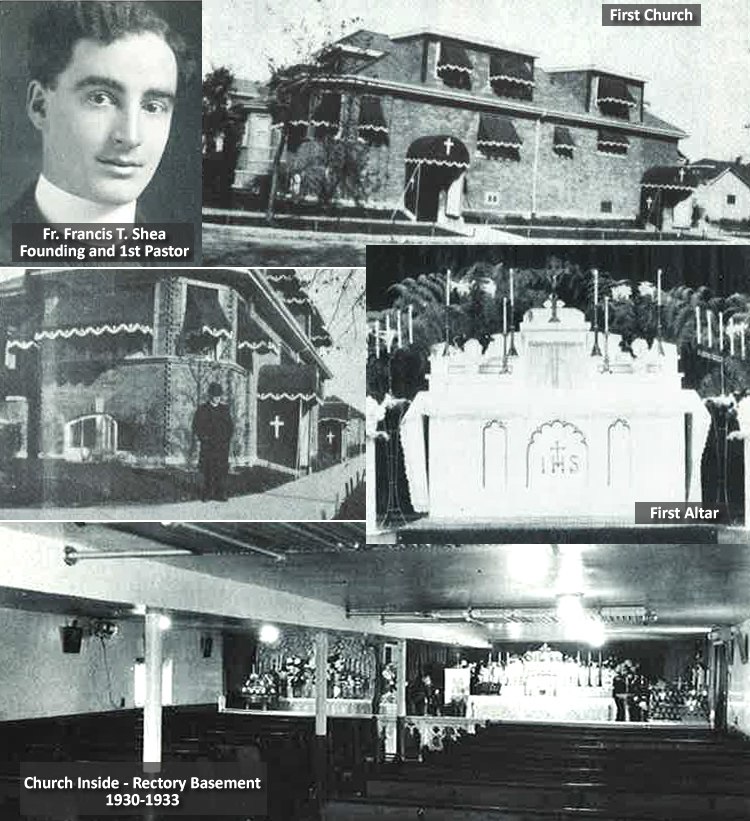
If anyone ever started from a patch of dirt, it was he. Gathering together the early pioneers, Father Shea and his helpers literally plowed the fields, and leveled the ground. While holding Mass in parishioner basements, at “open-air” parish missions and at the new John Mills School, they hammered the early framework of the modest structures that, on September 26, 1930 was formally established as St. Celestine Parish. The “only miniature parish church in America” as it was situated in the basement of a bungalow located at 3001 North 76th Court and it soon became the building of the frame church, which served as our humble House of God for nearly a quarter of a century. Additions, extensions and consolidations were resorted to as the years passed and the parish grew in numbers and requirements.

1933 – Dedication at the combined Church, School, and Auditorium at 3020 North 76th Court
On February 19, 1933, parishioners of the fledgling parish participated in the dedication of a combination church, school and auditorium at 3020 North 76th Court. The new facilities provided sufficient accommodations for Sunday Mass, four classrooms for the first school of the parish, and a meeting place for social activities. Father Shea kept parishioners informed of parish activities through the publication of a monthly calendar of events.
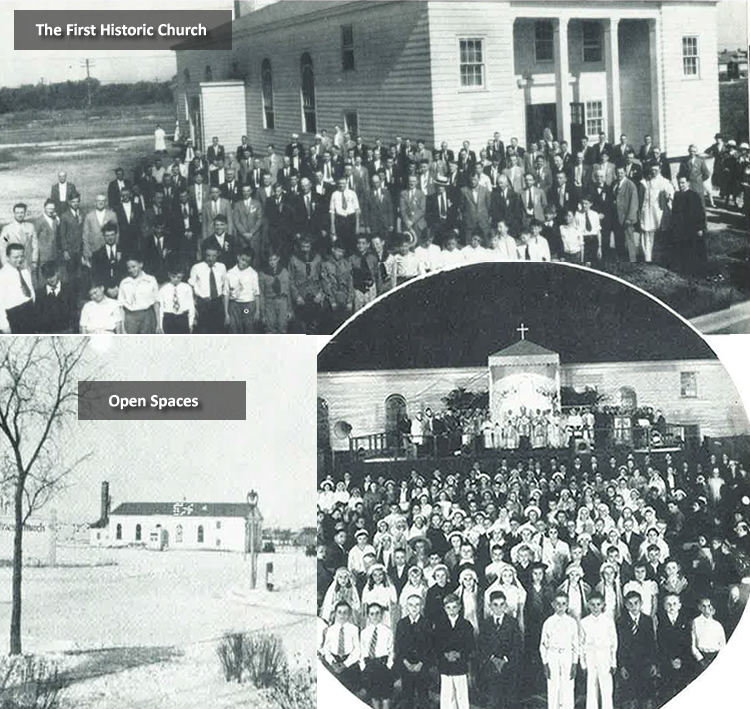
Finally, Father’s Shea’s dream of a school started taking shape. He succeeded in bring in the Sister of St. Dominic of Adrian, Michigan (Adrian Dominicans) to the parish to form the faculty. Portable partitions, six-feet high, were placed in the church building to divide it into four classrooms. Folding chairs with detachable arms were used as desks.
With ninety-one children registered for the first four grades, school opened on October 1, 1936.
The physical burden of founding a parish out of a prairie was beginning to take its toll on this frail, scholar-priest and he was transferred to lighter duties as a chaplain in Waukegan. The weight of carrying on the leadership of the parish to new dreams and heights was entrusted to new, younger hands.
1945 – Father O’Donnell enters the scene and a new school is built
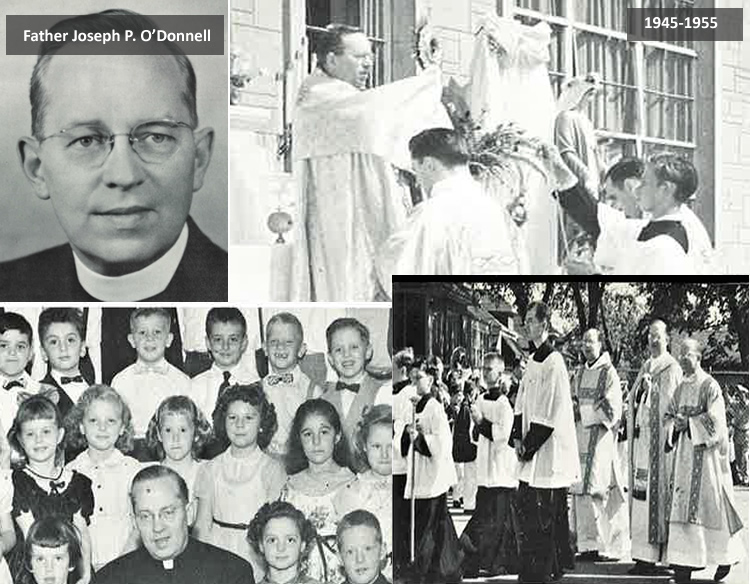
As Word War II was drawing to a close, Cardinal Stritch selected Father Joseph P. O’Donnell to lead the people of St. Celestine in 1945. He saw, immediately, the need for a larger permanent school with the necessary student facilities; the New School Fund was on its way. Time and again the loyal Celestinians rallied around Father O’Donnell. Beginning with a loan of nearly a half million dollars (a huge debt for those early days), the good pastor broke ground in 1946. With the acquisition of more land on 77th Avenue, the parish building program moved into high gear. Foundations went in, walks went up, and children moved into kindergarten and higher classrooms. The good Sisters followed soon after into a convent of their own, complete with laundry, kitchen, refectory and chapel. Indeed, Father O’Donnell did not stop at that. Looking ahead to the further needs, he added an all-purpose auditorium, shower rooms, a parish kitchen and clubrooms. The cornerstone for the school was set in place on June 8, 1947 and the school opened its doors in September 1947 with 650 children enrolled.
1955 – Silver Jubilee
He continued to expand his energies in the one general direction: to make St. Celestine’s a full and complete parish. The corner buildings of 76th Court and Wellington Avenue were refashioned into a combined rectory and office. Black topping and fencing provided safe playing conditions for the children. The old church was extended both front and back to allow for a vestibule, a choir loft, and the recessing of the altars.
When the parishioners gathered at 12 noon on September 11, 1955 to mark the Silver Jubilee of the founding of St. Celestine Parish, a sense of accomplishment filled their hearts. In 25 years, the parish had grown from a “miniature parish church” seating only 100 people to a structure that accommodated 675. The school too had grown exponentially. And the parish was known for its first-of-a-kind offering for Chicago area Catholics: open air missions. At the Jubilee celebration, Samuel Cardinal Stritch praised the efforts and dedication of the people of the parish as a source of pride for him as Archbishop.
Father O’Donnell thus spent the prime years of his pastorate pursuing the dream that all pastors must envision, a sufficient and monumental parish House of God. He died in October of 1967.
1966 – Father Neenan is pastor
Father Phillip J. Neenan was assigned as the third pastor on March 4, 1966, after Father O’Donnell’s the retirement due to illness. Father Neenan knew that a building project lay ahead of him – this time not a school – but a new parish church.
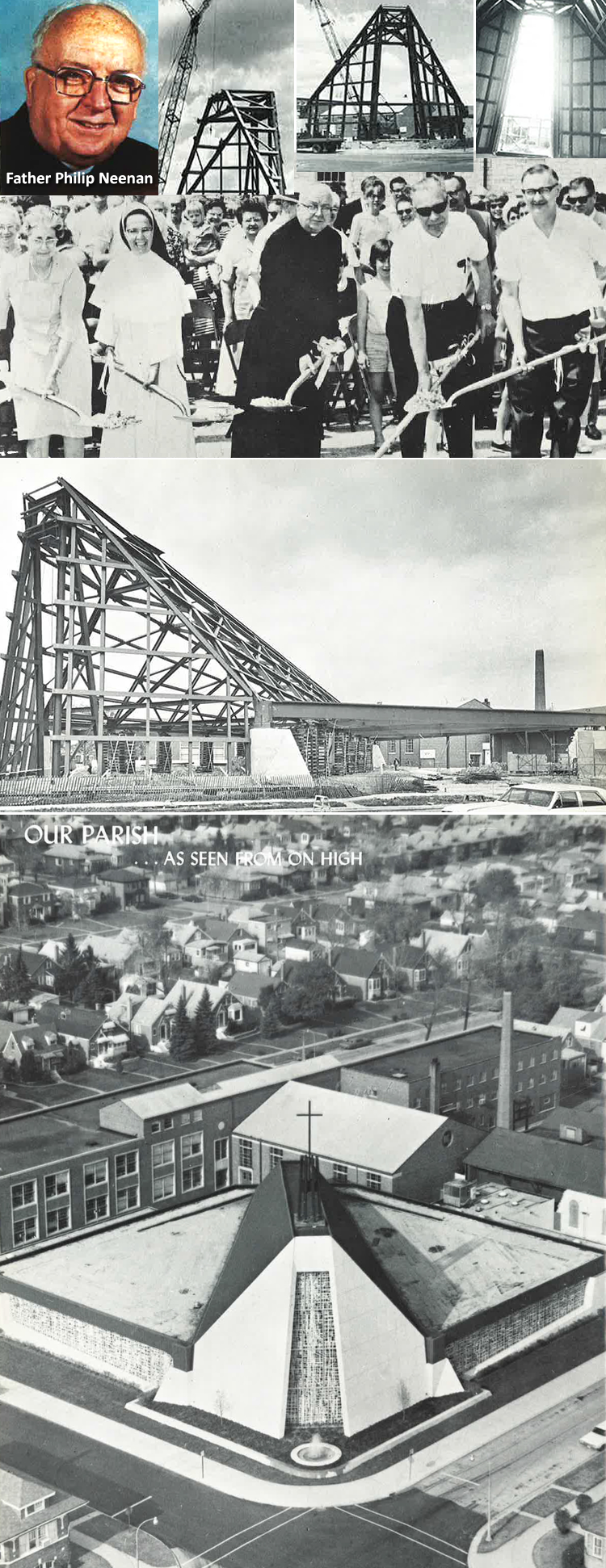
In the spring of 1966, he came, and symbolically, “there was no room for him in the inn.” For half a year he was obliged to rent accommodations at the Circle and to shuttle back and forth to the parish. But plans were already turning over in his mind. He began slowly buying up properties needed for the ultimate expansion.
Just as the long-time dream of the parishioners for a new beautiful and permanent church seemed close to fulfillment, the recommendation of Vatican Council II on architecture were sounded throughout the world. These changes necessitated new plans for the future, particularly in regard to the warmth and close community feeling so lacking in the huge churches and cathedrals of the past.
To ensure that St. Celestine’s would be in keeping with the mind of the Church in these matters, Father Neenan began a survey on a scale never before attempted by a planning pastor. In addition, he maintained contact with the Guild of Religious Architects, which furnished four hundred color slides each week for his study. The swift and perfect giving made an early groundbreaking, and construction started in June of 1968. Meanwhile, Masses were added in Holy Cross High School.
1971 – The new church altar is consecrated and the church is dedicated
Finally, in 1970, the new church of St. Celestine was under roof and Bishop McManus came to consecrate the altars. The finishing touches to the edifice continued for yet another year. When at last all things were in place, Cardinal Cody, assisted by a large turnout of friends and classmates of Father Neenan, dedicated this glorious house of worship. After years of planning, fundraising and hard work, the parish’s dream was actualized in the dedication of the new church building on November 7, 1971.
With knowledge of his impending retirement already in mind, Father Neenan joyfully led the parishioners through the celebration of the parish’s 50th anniversary. On October 19, 1980, John Cardinal Cody presided at the Golden Jubilee Mass. In the years immediately leading up to 1980, the Pastoral Center was built and the Annex was created. Social events such as Showboat, the Parish Picnic and Las Vegas Nights brought the community together for laughter and camaraderie.
Following Father Neenan’s retirement in 1981, Father Patrick O’Malley was appointed pastor. Father O’Malley had been serving at St. James Parish at 29th and Wabash. During his tenure as pastor, in 1990 he was appointed Vicar for Priests by Cardinal Bernardin. His successor was Father Lawrence McBrady, who, like Father O’Malley, served a short tenure of six years from 1991 to 1996, and was also appointed as Vicar for Priests when Father O’Malley was appointed to the faculty of the seminary in Mundelein. Father Neenan was called home by the Lord on March 26, 1995, after many decades of faithful priestly service.
In late 1999, the young associate pastor of St. Celestine’s, Father Larry Sullivan, after serving almost six years at the parish, was appointed by Cardinal George as the seventh pastor. Under Father Sullivan’s leadership, services and ministries continued to flourish, and the parish successfully kicked off a Millennium Campaign to raise funds for much-needed improvements to the parish plant.
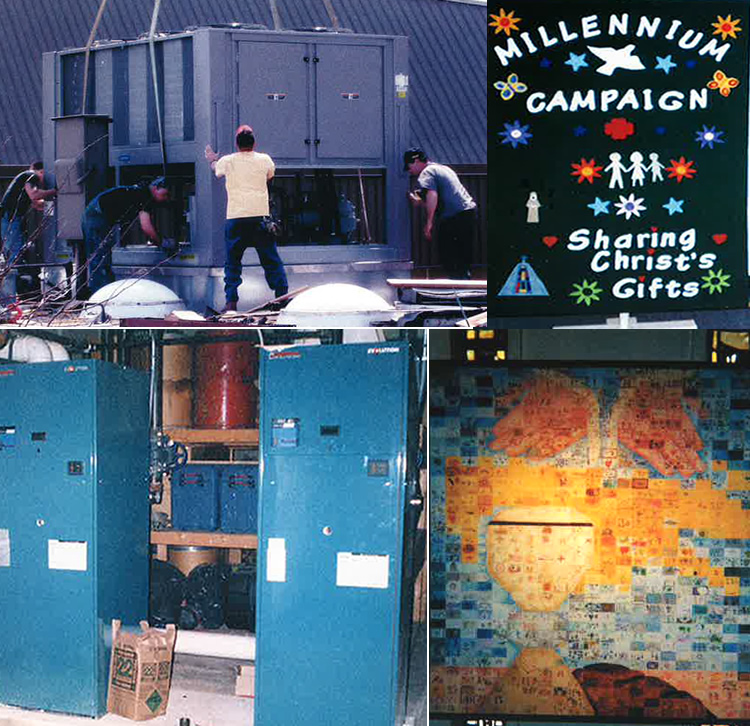
2004 – 75th Anniversary
In 2004, the parish began the celebration of the 75th anniversary of its founding. God has richly blessed the parish of St. Celestine over the past three quarters of a century with a rich faith, with service to others, and with a strong Christian community. St. Celestine Parish looks back gratefully over the past 75 years, and looks forward in hope to the future.
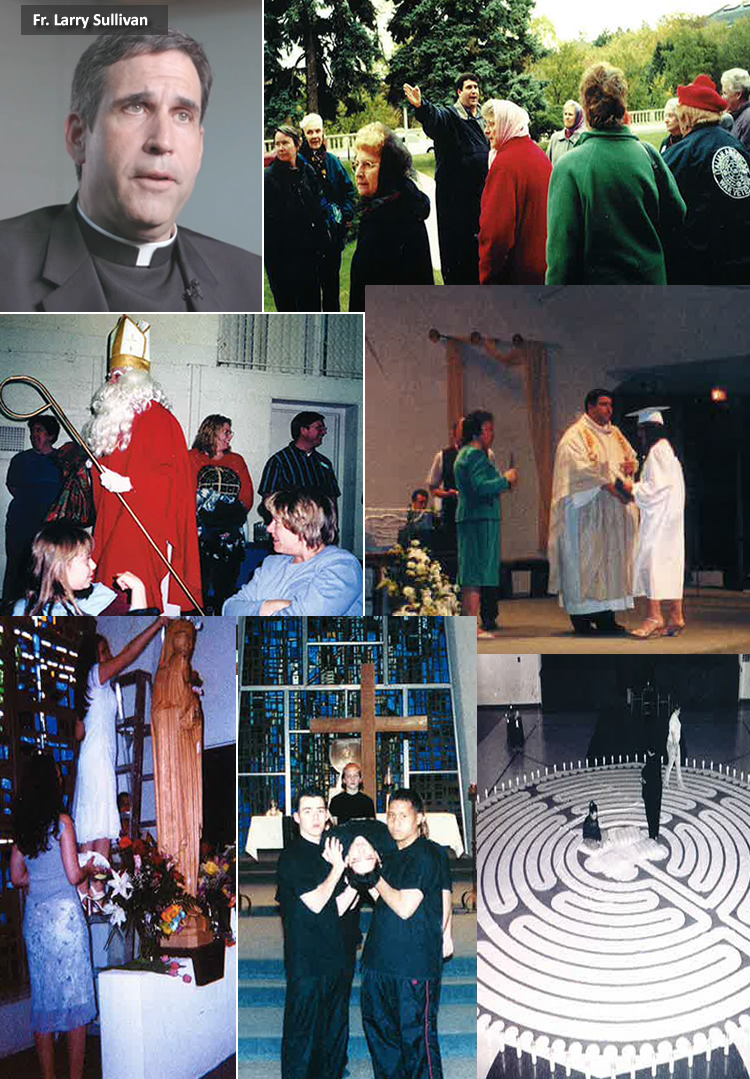
Father Sullivan oversaw the renovations of the parish church in preparation for the parish’s Diamond Jubilee, a celebration led by Francis Cardinal George on November 11, 2005.
Eighty years later in 2010, a Catholic community originally comprised of Italians, Irish, and Polish still maintains the same ethnic mix with the happy addition of Hispanics and Filipinos. In spite of difficult economic times, the parish school remains strong and Catholic education is prized as a core value of the parish’s mission. The dedicated people of Saint Celestine Parish stand proud as a community of faith, united around their Eucharistic Lord. Their faith leads them into the future with confidence.
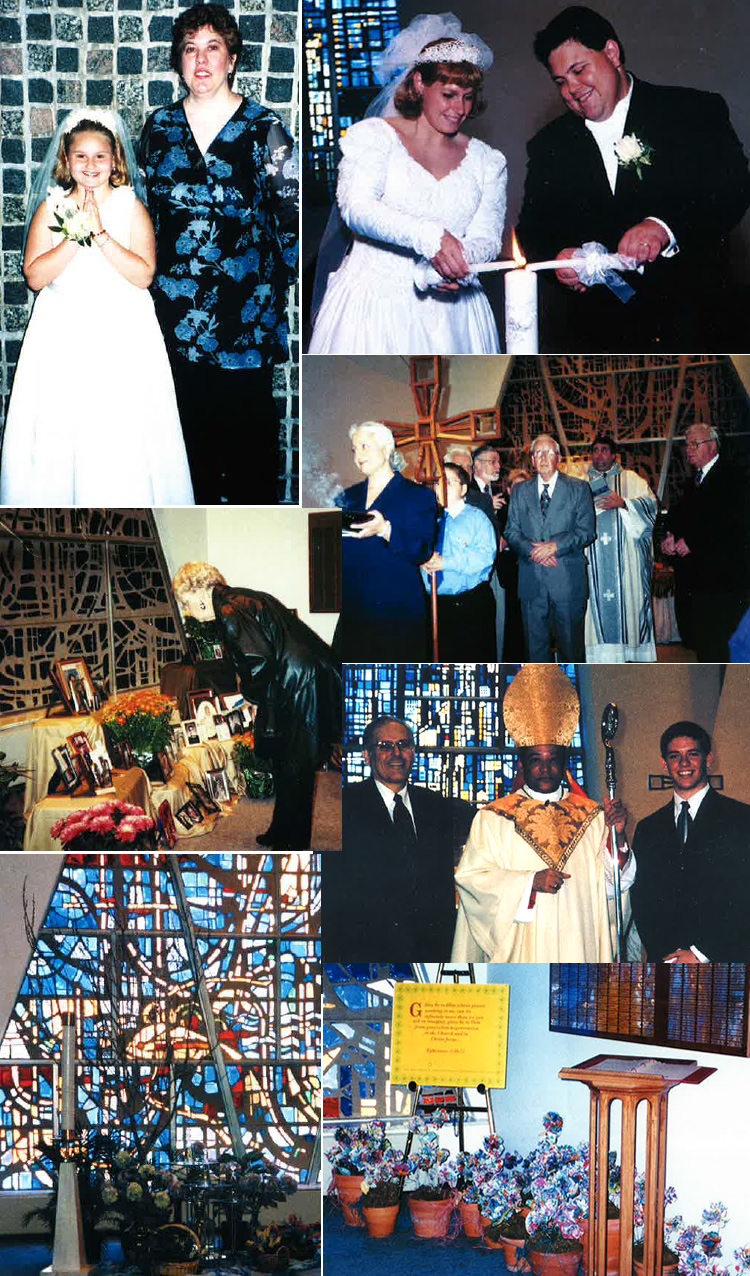
More Recent History
In 2005, the parish was part of the millennium campaign that the archdiocese held. With the money received from this campaign, Fr. Larry and staff completed renovation of the inside of the church. New carpet and pews were installed and the interior was painted warmer colors. The baptismal font was moved and enlarged to make it large enough for immersion baptisms and a new organ was purchased for the church. In 2007 funds were raised to purchase a bus to bring parishioners to and from mass, and our Transportation Ministry followed.
In 2008, Father Jeffrey Grob became the new pastor, while also working for the Archdiocesan Chancery. During his time as pastor, he reached out to the community when he restarted the Simbang Gabi Mass, and instituted the Our Lady of Guadalupe Mass, bringing beautiful new traditions to our more diverse parish. The Prayer Blanket Ministry was started and the Women’s Club became active. The Parish BBQ was transitioned to the Taste of St. Celestine and the school celebrated their 75th Anniversary of providing high-quality Catholic education to the Elmwood Park and Chicago community. As Father Jeff’s duties at the Archdiocese became more numerous, help was needed, and Father Paul Duy Cao became pastor in 2013.
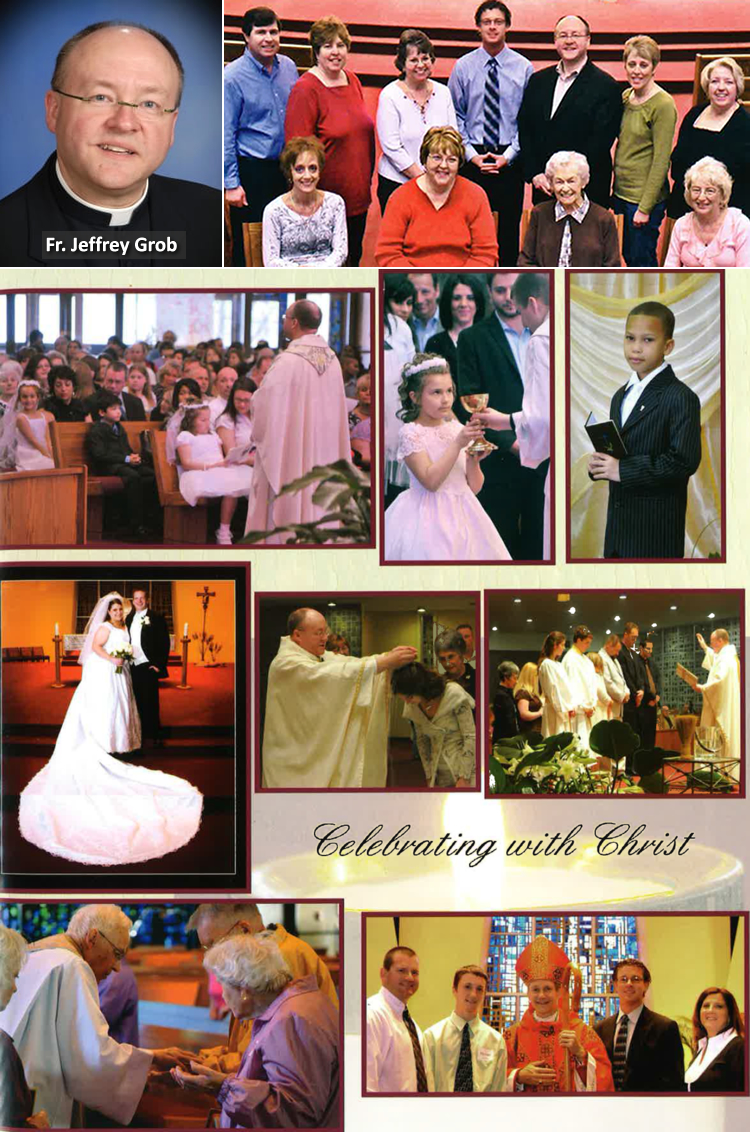
Father Paul Cao has been given the difficult job of guiding the parish through the Parish Transformation and Renew My Church programs. He has worked hard to provide compassionate leadership in a time of dwindling numbers of parishioners in the pews and revenue for the parish. We have a large well-run school with wonderful athletic, scouting, and extra curricular programs as well as stellar Catholic education. The Religious Ed program remains strong. As a result of the Archdiocesan process, St. Celestine and St. Cyprian parishes were combined to form the new parish St. Mother Theodore Guerin as of July 1, 2018. The parish encompasses parts of Chicago, Elmwood Park, and River Grove. We don’t know what the future will bring, but we trust that the Holy Spirit will guide our new parish.
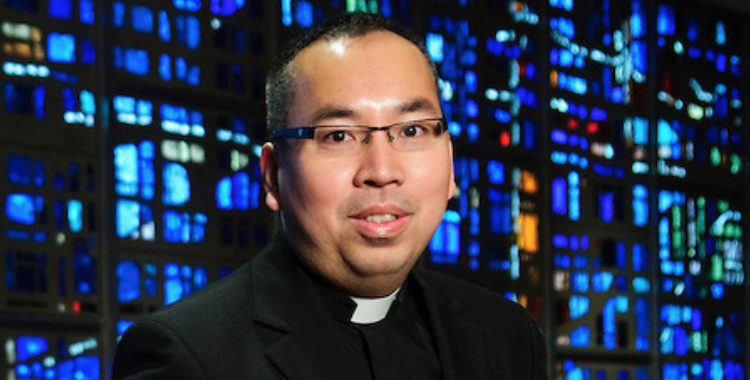
Who was St. Celestine?
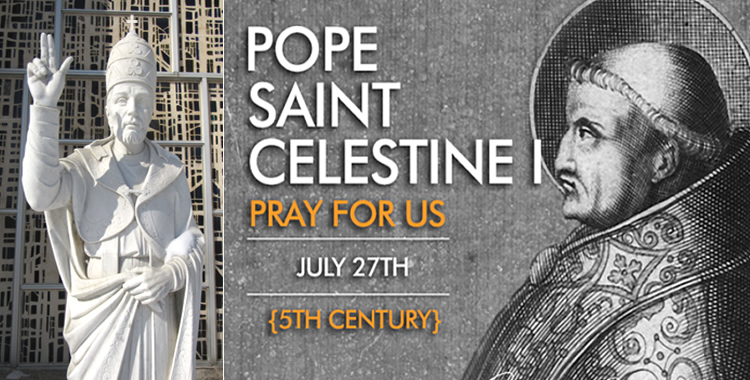
Pope St. Celestine I
Pope from 422-432 AD
Died 432 AD
Feast Day on July 27
Information from flocknotes.com
Prior to being elected on September 10, 422, St. Celestine I lived in Milan and worked for St. Ambrose. He’s also mentioned by Innocent I (Pope #40) as “Celestine the Deacon.” St. Augustine was very fond of Celestine, having written him a letter after his election exhorting the pope’s help to handle an issue with a fellow African bishop. The feeling was mutual, which we know from a letter Celestine wrote to the bishops in Gaul (western Europe) after Augustine’s death in 430. In it he detailed, as the Catholic Encyclopedia read, “the sanctity, learning and zeal of the holy doctor and (Celestine) forbade all attacks upon his memory” from those who had an axe to grind with Augustine. Celestine I ruled for nine years, ten months, and sixteen days, and died on July 26, 432.
Pope St. Celestine is known for having been the first to deal with a new heresy, known to us as Nestorianism. Nestorius was the bishop of Constantinople when he began preaching the heretical idea that Christ was in fact two distinct persons, not a single person with both a divine and human nature.
Nestorius also didn’t like the descriptor Theotokos, or “God bearer” that was often given to the Virgin Mary. St. Cyril of Alexandria wrote to Celestine I, asking for his blessing to excommunicate Nestorius and condemn his teaching. Celestine gave Cyril the green light, which led to Nestorianism being condemned at the Council of Ephesus in 431.
In a sense, we can thank Celestine I for St. Patrick’s Day. Just before his death, it was Celestine who commissioned Patrick, the great patron of Ireland, to begin evangelizing there; and in his last official act as Pope.
More on St. Celestine:
History tells us very little of St. Celestine’s private life. He was born in Campania and had been for some time a conspicuous figure as deacon in Rome before he was unanimously elected Pope in September A.D. 422.
During the ten years of his pontificate, he showed considerable energy in counteracting the heretical movement of the Pelagians and Nestorians. Through his Legates, he presided over the great council of Ephesus (A.D. 431). He left a permanent impression on the ritual of the Church in liturgical matters.
We may trace to him the gems of the recognition of the Divine Office as an obligation incumbent upon the clergy. He is credited with the building of the Basilica of Santa Sabina in Rome and he is recognized as the Holy Father who sent St. Patrick to Ireland. The Roman Martyrology records his death as July 27, 432 A.D. He was buried in the catacomb of St. Priscilla. His relics since have been removed to the church of St. Praxedes.